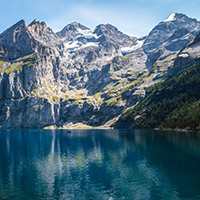Modelling physical and ecological processes in medium-to-large deep European perialpine lakes: a review

Accepted: 5 October 2021
HTML: 125
All claims expressed in this article are solely those of the authors and do not necessarily represent those of their affiliated organizations, or those of the publisher, the editors and the reviewers. Any product that may be evaluated in this article or claim that may be made by its manufacturer is not guaranteed or endorsed by the publisher.
Authors
In this paper we review a significant sample of the modelling studies carried out on medium-to-large deep European perialpine lakes (MLDEPLs). The reviewed bibliographic corpus was obtained querying Elsevier’s Scopus® database with a tailored search string on 8 January 2021. Results were filtered, accepting only journal papers written in English dealing with natural lakes having surface area > 10 km2. A list of 75 works was obtained, published between 1986 and 2021. Most studies have been carried out on Swiss lakes (44 out of 75 papers), Lake Geneva being the most investigated environment. A significant positive correlation was found between lake surface area and volume and the number of dedicated papers, suggesting that scientific attention is higher for environments characterised by large dimensions and relevant socio-economic interests. Both the number of papers and their citation count have experienced an exponential growth in time, pointing to a rising interest in quantitative modelling applications, but also to the increasing availability and ease of use of numerical modelling tools. Among the 75 selected papers, 55 employ a hydrodynamic driver, used alone or coupled with an ecological module, while the remnant 20 works adopt an ecological-only model. Among the papers employing hydrodynamic models, the use of three-dimensional (3D) drivers is surprisingly slightly more frequent (28 papers) than that of one-dimensional (1D) ones (26 papers), with most 3D applications having been published in the last 2011-2020 decade (24 papers). This reflects the interest on the hydrodynamic processes leading to the observed spatial heterogeneities in the biochemical properties of the MLDEPLs. However, coupling of ecological modules with 3D hydrodynamic drivers, to directly simulate these phenomena, is still restricted (2 papers) compared to that of 1D hydrodynamic drivers (8 papers), due to calibration and computational difficulties, which could be strongly reduced by future research achievements. Nevertheless, 1D models allow performing long-term prognoses considering multiple climate change and watershed management scenarios, due to their much smaller computational burden. The largest group of works dealing with ecological-only models (6 papers) is dedicated to applications of phosphorus budget models, which can above all be used to forecast variations in lake productivity in response to changes in the availability of the limiting nutrient.
Graphical abstract
How to Cite

This work is licensed under a Creative Commons Attribution-NonCommercial 4.0 International License.
Similar Articles
- Johan C. Varekamp, Lake contamination models… , Journal of Limnology: Vol. 64 No. 2 (2005)
- Gerhard MAIER, Berit SPETH, Wolfgang ARP, Mandy BAHNWART, Peter KASPRZAK, New records of the rare glacial relict Eurytemora lacustris (Poppe 1887) (Copepoda; Calanoida) in atypical lake habitats of northern Germany , Journal of Limnology: Vol. 70 No. 1 (2011)
- Svein Birger WÆRVÅGEN, Jens Petter NILSSEN, Life histories and seasonal dynamics of common boreal pelagic copepods (Crustacea, Copepoda) inhabiting an oligotrophic Fennoscandian lake , Journal of Limnology: Vol. 69 No. 2 (2010)
- Belinda GALLARDO, Stéphanie GASCÓN, Mercedes GARCÍA, Francisco A. COMÍN, Testing the response of macroinvertebrate functional structure and biodiversity to flooding and confinement , Journal of Limnology: Vol. 68 No. 2 (2009)
- Gianluca CORNO, Emanuele CARAVATI, Cristiana CALLIERI, Roberto BERTONI, Effects of predation pressure on bacterial abundance, diversity, and size-structure distribution in an oligotrophic system , Journal of Limnology: Vol. 67 No. 2 (2008)
- Rolf SCHUSTER, Hartmut GREVEN, A long-term study of population dynamics of tardigrades in the moss Rhytidiadelphus squarrosus (Hedw.) Warnst , Journal of Limnology: Vol. 66 No. s1 (2007): 10th International Symposium on Tardigrada
- Wolfram SCHEFFLER, Giuseppe MORABITO, Topical observations on centric diatoms (Bacillariophyceae, Centrales) of Lake Como (N. Italy) , Journal of Limnology: Vol. 62 No. 1 (2003)
- Roberto CANULLO, Giandiego CAMPETELLA, Maria-Cristina ALLEGRINI, Vincenzo SMARGIASSI, Management of forest vegetation data series: the role of database in the frame of Quality Assurance procedure , Journal of Limnology: Vol. 61 No. s1 (2002): National Programme for Forest Ecosystems Control CONECOFOR
- Renato BAUDO, Biological monitoring of aquatic ecosystems in Italy , Journal of Limnology: Vol. 60 No. s1 (2001): Scientific and legal aspects of biological monitoring in freshwater
- Danilo TAIT, Bertha THALER, Atmospheric deposition and lake chemistry trends at a high mountain site in the eastern Alps , Journal of Limnology: Vol. 59 No. 1 (2000)
<< < 64 65 66 67 68 69 70 71 72 73 > >>
You may also start an advanced similarity search for this article.
-
Andrea Fenocchi, Nicolò Pella, Diego Copetti, Fabio Buzzi, Daniele Magni, Nico Salmaso, Claudia DrestiJournal of Contaminant Hydrology : 2025
-
Paolo Dezuanni, Diego Copetti, Claudia Dresti, Nicolò Pella, Fabio Buzzi, Andrea FenocchiFrontiers in Environmental Science : 2025
-
Laura M. V. Soares, Olivia Desgué‐Itier, Cécilia Barouillet, Céline Casenave, Isabelle Domaizon, Victor Frossard, Nelson G. Hairston, Andrea Lami, Bruno J. Lemaire, Georges‐Marie Saulnier, Frédéric Soulignac, Brigitte Vinçon‐Leite, Jean‐Philippe JennyLimnology and Oceanography Letters : 2025
-
Diego CopettiResources : 2023
-
Andrea Fenocchi, Fabio Buzzi, Claudia Dresti, Diego CopettiEcological Indicators : 2023
-
L.M.V. Soares, M. Thouillot, V. Frossard, O. Desgué-Itier, C. Barouillet, Y. Baulaz, J.-C. Clément, I. Domaizon, J.-M. Dorioz, C. Goulon, J. Guillard, S. Jacquet, E. Réalis, V. Tran Khac, J.-P. JennyEcological Indicators : 2025

 https://doi.org/10.4081/jlimnol.2021.2041
https://doi.org/10.4081/jlimnol.2021.2041




